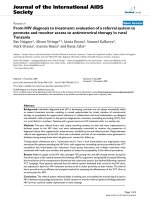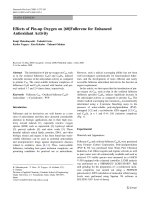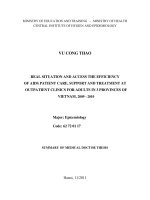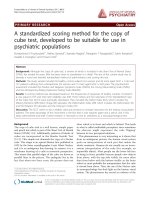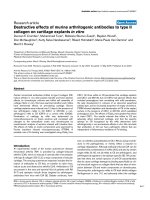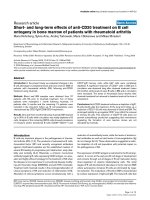Applying side effects of anti fibrotic compounds to promote neovascularization for tissue engineering
Bạn đang xem bản rút gọn của tài liệu. Xem và tải ngay bản đầy đủ của tài liệu tại đây (4.44 MB, 119 trang )
1
1. LITERATURE REVIEW
1.1. Neovascularization in Tissue Engineering
Regenerative medicine encompasses a variety of research areas including cell therapy,
biomaterials engineering, growth factors and transplantation science. Most of these
efforts converge into tissue engineering, an exciting field which offers a means of
developing biological substitutes for maintaining, restoring and improving tissue
function
1
. One of the major challenges in tissue engineering today is the generation of
large vascularized 3D-structures
2,3
. Cells require a constant supply of essential nutrients
and oxygen as well as a constant removal of metabolic waste products. Vascularization is
thus essential for maintaining the survival and function of tissue engineered constructs in
vitro and vivo, as cellular viability decreases steeply beyond a few hundred μm from a
blood supply
4
.
One of the major challenges in tissue engineering is how accelerate neovascularization of
an implanted tissue construct. Current technology limits the survival of implanted tissues
as they depend initially on diffusion and later on neovascularization. Diffusion is
insufficient for survival of the tissue and limits the thickness of the implants. Dependence
on neovascularization can cause fibrovascular ingrowth and hence scarring. Presently,
there are no established methods to prefabricate a capillary network in tissue constructs
that could connect with the host vasculature after implantation
5
. Currently, strategies to
improve vascularization prior to or after implantation involve the use of growth factors,
endothelial cells and endothelial progenitor cells. They can be summarized into the
following four approaches:
2
i) Pre-vascularization of polymeric scaffolds by host.
Prevascularization of polymeric scaffolds can be achieved by implanting the polymeric
scaffold without the tissue construct at selected body sites first so that vascularization
may occur before subsequent implantation of the tissue construct or cells into the
vascularized matrix
6
. This may be feasible in an animal model, but would require
multiple surgeries for a human patient. Pre-vascularization using an animal host presents
potential host immune reactions and risk of animal disease transmission.
ii) Use of angiogenic growth factors.
Vascular endothelial growth factor (VEGF) and basic fibroblast growth factor (bFGF) are
potent inducers of angiogenesis. However, such angiogenic growth factors are inherently
unstable in vivo, therefore bolus injections of the recombinant protein has limited use in
neovascularization of implants. Sustained release of the exogenous growth factors may be
achieved by integration or encapsulation within biodegradable polymers as
microspheres
7,8
or as part of a scaffold
9
. Another method of achieving sustained release
of VEGF was developed using microsphere encapsulated cells transfected with VEGF
cDNA, but this is dependent on cellular uptake and translation of the cDNA
10
. There are
also issues with the safety of using transfected cells for gene therapy due to the
transfection vector. Unfortunately, overproduction single angiogenic factors often results
in deformed or non- functional blood vessels
11
.
3
iii) Seeding endothelial cells on a biodegradable matrix together with VEGF
transfected cells.
This method ensures sustained release of VEGF to maintain the viability of endothelial
cells after implantation
2
. Another group used embryonic fibroblasts to maintain VEGF
levels in a tri-culture of endothelial cells and myoblasts to engineer vascularized skeletal
muscle tissue
12
in vitro. Perfusion, vascularization and survival of the muscle tissue
constructs after transplantation was improved.
iv) Co-seeding scaffolds with progenitor cells.
The use of stem cells is another avenue that shows promise. In the presence of
angiogenic factors such as VEGF, they may be differentiated into endothelial progenitor
cells
13
. Co-implantation of vascular endothelial cells with mesenchymal precursor cells
on a three dimensional collagen gel resulted in differentiation of the precursor cells into
mural cells. Implantation of this construct into mice produced capillary like tubes, some
of which eventually became perfused and joined with the host vasculature, a process
called inosculation
14
. Others have used bone marrow derived endothelial progenitor cells
seeded together with other cell types, such as hematopoietic progenitor cells to produce a
vascularized matrix
15,16,17
.
1.2. HIF-1α: An Alternative Approach to Neovascularization
Prolyl 4-hydroxylase inhibitors may be an alternative method of neovascularization by
chemically stimulating angiogenesis via stabilization of HIF-1 and upregulation of HIF-1
target genes.
4
As angiogenesis is a complex process involving many different factors, the use of
exogenous angiogenic factors alone may not produce functional vascular networks.
Instead of trying to optimize a recipe of cells and growth factors for vascularization to
occur, this approach may achieve a more physiological response, similar to hypoxic stress,
by using HIF-1 as a master switch.
Targeting HIF-1 has the advantage of bypassing the downstream complexity of multiple
cell signaling molecules and angiogenic factors involved in the process of angiogenesis.
The cells are directed by HIF-1 to produce a number of resulting gene products
endogenously, rather than attempting to recreate the series of events leading to
angiogenesis by the use of exogenous growth factors and progenitor cell types. The
amount and timing of these growth factors and signaling molecules are determined and
controlled by the cells, therefore more closely resembling physiological stimulation of
angiogenesis. This method would also remove the need of genetically manipulated cells.
Alternatively, it may augment the rate of vascularization if used together with engineered
tissues and scaffolds containing endothelial cells or endothelial progenitor cells. This
proposed approach is novel for improving neovascularization in tissue engineering.
1.3. Regulation of HIF-1
Hypoxia inducible factor 1 (HIF-1) is a key transcription factor that is upregulated in
response to hypoxia. Hypoxia is a common physiological stress imposed by low oxygen
conditions to cells or tissues. HIF-1 is a heterodimer consisting of two subunits, a
5
hypoxia regulated HIF-1α and an oxygen insensitive subunit HIF-1β
18 , 19
. HIF-1α
consists mainly of a basic-helix-loop-helix (bHLH) region, a Per/Arnt/Sim (PAS) region,
a N-terminal transactivation domain (N-TAD) and a C-terminal transactivation domain
(C-TAD) (Figure 1 extracted from Kaelin 2005
19
).
Figure 1. Schematic representation of HIF-1
α
protein domain structures (Kaelin 2005
19
)
Under normoxia, posttranslational hydroxylation of HIF-1α occurs at conserved proline
residues (Pro 402 and Pro 564) within a polypeptide segment known as the oxygen
dependent domain (ODD) found at the N-terminal transactivating domain (N-TAD)
region
19,20,21
. These hydroxylated prolyl sites interact with the von-Hippel Lindau tumor
suppressor protein (pVHL), which is the recognition protein for the E3 Ubiquitin Ligase
complex
19,20,21, 22 , 23
. The ubiquitin ligase complex subsequently packages HIF-1 for
proteosomal degradation via polyubiquitylation, therefore HIF-1 is highly unstable under
normoxia
19,20,22
. In addition, an asparaginyl hydroxylase, Factor Inhibiting HIF-1 (FIH-1),
acts on asparaginyl residue Asn 803, found on the C-terminal transactivating domain (C-
TAD) region of HIF-1α, blocking the site and preventing its interaction with the
transcriptional activator p300
20,24,25
(Figure 2).
6
Under hypoxic conditions, the oxygen dependent prolyl hydroxylase enzymes is inhibited,
thus HIF-1 is not hydroxylated and accumulates in the cell. Hypoxia also prevents
hydroxylation of the C-TAD region, allowing HIF-1α to interact with p300 and promote
transcription of target genes.
1.4. HIF-1 Target Genes
HIF-1 target genes (Figure 3) are expressed in hypoxic situations, with many of them
found to be involved in cell metabolism, vascular remodeling and angiogenesis
18, 26
.
Specifically, vascular endothelial factor (VEGF) is well established as an angiogenesis
promoting growth factor involved in endothelial cell proliferation, migration and
Figure 2. Regulation of the
HIF-1 transcription factor
(From Bruick & McKnight
2002
20
). Under normoxic
conditions, the ODD of HIF-
1α is modified by a HIF–
prolyl hydroxylase, triggering
HIF-1α recognition by pVHL
and subsequent degradation
by the proteasome. Similarly,
an asparaginyl hydroxylase
modifies the C-TAD of HIF-
1α, blocking its interaction
with the transcriptional
coactivator p300. Hypoxia
blocks both prolyl
hydroxylation and
asparaginyl hydroxylation,
allowing HIF-1α to
accumulate and bind to p300,
thereby promoting the
transcription of downstream
HIF-1 target genes, thus
enabling cells and the whole
organism to adapt to hypoxia.
7
differentiation
27,28,29
. It is often used as a positive control for stimulating angiogenesis.
VEGF receptor-1 (VEGFR-1), also known as FLT-1, is a tyrosine kinase receptor
involved in endothelial cell migration, autocrine signaling and induction of matrix
metalloproteinase-9 (MMP-9)
27,28,29
. Others, such as erythropoietin (EPO), signal the
requirement for production of red blood cells, which is important in hypoxia
30
, and
ischemic diseases
31
.
Figure 3. Genes that are directly regulated by HIF-1
18,32
. Many of these gene products
of HIF-1 transcription are related to angiogenesis, such as erythropoietin for the
production of red blood cells, insulin like growth factor and its binding proteins, VEGF
and its receptor FLT-1.
Gene product
ABCG2
α
1β
-Adrenergic receptor
Adrenomedullin
Aldolase A (ALDA)
Atrial natriuretic peptide
Carbonic anhydrase 9
CD18
Ceruloplasmin
C-MET
Connective tissue growth factor
CYP3A6
CXCR4
DEC1
DEC2
Ecto-5’-nucleotidase (CD73)
Endocrine gland-derived VEGF
Endoglin
Endothelin-1
Enolase 1
ENOS
Erythropoietin
ETS-1
Glucose transporter 1 (GLUT1)
Glyceraldehyde-3-phosphate dehydrogenase
Glucose regulated protein, 94-kDa (GRP94)
Heme oxygenase-1
HIF-1α prolyl hydroxylase PHD3 (EGLN3)
HIF-1α prolyl hydroxylase PHD2 (EGLN1)
HGTD-P
ID2
Integrin β
2
Intestinal trefoil factor
Lactate dehydrogenase A (LDHA)
Lactase
Leptin
Membrane type-1 matrix
metalloproteinase
Multi-drug resistance 1 (ABCB1)
Myeloid cell factor 1 (MNL1)
Nitric oxide synthase 2
NIP3
NUR77
p35srj (CITED2)
Phosphoglycerate kinase 1
6-Phosphofructo-2-kinase/fructose-2,6-
bisphosphatase-3 (PFKFB3)
6-Phosphofructo-2-kinase/fructose-2,6-
bisphosphatase-4 (PFKFB4)
Plasminogen activator inhibitor 1
Procollagen prolyl-4-hydroxylase α(I)
RORα
Stromal-derived factor 1 (SDF-1)
Telomerase (TERT)
Transferrin
Transferrin receptor
Transforming growth factor β
3
Vascular endothelial growth factor
(VEGF)
VEGF receptor-1 (Flt-1)
8
1.5. HIF-1α Promotes Angiogenesis
There is a considerable amount of evidence published on the involvement of HIF-1α in
promoting angiogenesis. This has been reviewed extensively
18,26,32
, therefore only a brief
summary will be given here.
Ischemia results in cellular exposure to hypoxic microenvironments. By stabilization of
HIF-1, the cell automatically signals the requirement for growth of blood vessels to the
ischemic site by upregulating the local production of angiogenic factors. This is also
often the case in cancers, where HIF is activated by physiological hypoxia within a
rapidly growing tumour cell mass
32,33
. Overexpression of HIF-1α has been found with an
associated increase in microvessel density and VEGF expression in several cancers, such
as bladder, breast, colon, ovarian and pancreatic cancers
32
.
HIF-1 is also critical in angiogenesis and embryogenesis. It was reported that HIF-1
deficient mouse embryonic cells produce major vascular defects in the yolk sac and
developing embryo, associated with severe hypoxia due to lack of perfusion
34
. Injection
of these HIF-1 deficient mouse embryonic stem cells into immunocompromised mice
resulted in smaller and less vascularized tumors compared to normal embryonic stem
cells.
Transgenic mice expressing constitutively active HIF-1α in the epidermis exhibited an
increase capillary density in the dermis and marked increase in VEGF
35
. Despite
hypervascularization, there was no edema, inflammation or vascular leakage, compared
9
to transgenic mice overexpressing VEGF cDNA in the skin
35,11
. Additionally,
administration of HIF-1α/VP16 recombinant plasmids constructed by fusion of HIF-1α to
the transactivation domain of herpes simplex virus VP16 has improved recovery of local
blood flow and vascularization in a rabbit hindlimb ischemic model
36
. Similar results
were obtained using an acute myocardial infarction rat model
37
. These evidences
demonstrate the involvement of HIF-1 in angiogenesis. Consequently, several approaches
have been undertaken to target HIF-1 for cancer therapy and treatment for ischemic
diseases
38,39
.
1.6. HIF Prolyl 4-Hydroxylases
There are three identified human cytoplasmic prolyl 4-hydroxylase isoenzymes that
hydroxylate HIF-1α
40 , 41
. Like collagen prolyl 4-hydroxylases, they are dioxygenases
dependent on Fe
2+
, oxygen, ascorbate and 2-oxoglytarate.
1.7. Prolyl 4-Hydroxylase Inhibitors (PHi) Promote Angiogenesis By Stabilizing
HIF-1α
Available literature on promotion of angiogenesis using prolyl 4-hydroxylase inhibitors
(PHi) is scarce at the moment. Gleadle et al (1995)
42
was one of the first to look at the
effect of prolyl hydroxylase inhibitors on HIF-1. Cobalt ions and iron chelators such as
desferrioxamine (also known as deferioxamine, or DFO), upregulated mRNA expression
of some HIF-1 target genes, namely VEGF, platelet derived growth factor A and B
(PDGF-A, PDGF-B), erythropoietin (EPO) and transforming growth factor β-1 (TGFβ-1).
10
The mRNA expression levels were compared to that induced by hypoxia in human
tumour cell lines like Hep3B, HepG2 (hepatoma) and HT1080 (fibrosarcoma).
Stabilization of HIF-1α has subsequently been reported using cobalt chloride
43
, 2-
oxoglutarate analogues such as N-oxalylglycine and dimethyloxalyglycine
(DMOG)
22,43,44
, nitric oxide (S-nitroglutathione)
45
, proprietary substances developed by
Fibrogen, Inc
46,47,48
, Proteosome inhibitors such as MG-132 may also induce nuclear
accumulation of HIF-1α
44,43
by preventing its degradation. In addition, aliphatic and
aromatic compounds such as pyridine-2,4-dicarboxylate and 3,4-dihydroxybenzoic acid
were found to be competitive inhibitors of HIF-prolyl 4-hydroxylase isoenzymes in
comparison to 2-oxoglutarate
41
.
Another study made use of recombinant polypeptide constructs bearing either of the two
prolyl residues on HIF-1α that are targeted for hydroxylation to induce nuclear
accumulation and stabilization of HIF-1α in transfected cell
49
. Stimulation of
angiogenesis was shown by formation of tubules by microvascular endothelial cells co-
cultured with these transfected cells and increased vascularization of subcutaneously
implanted polyurethane sponges injected with the fusion protein in a murine model
49
.
There are three reports on stimulation of angiogenesis using pharmaceutically induced
prolyl hydroxylase inhibition to stabilize HIF-1α, all published shortly before this
research study was begun
50,51,52
. Warnecke et al (2003) showed accumulation of HIF-1α
in western blots of lysates from human HT1080 fibrosarcoma cells, rat PC12W
11
pheochromocytoma cells and mouse 3T3L1 embryonic fibroblast like cells treated L-
Mimosine, ethyl 3,4-dihydroxybensoate (3,4-DHB) and 6-chloro-2-hydroxychinolin-2-
carbonic acid-N-carboxymethylamid (S956711). Their study also presented some
evidence of angiogenesis simulation by these prolyl hydroxylase inhibitors using a rat
sponge model, where implanted sponges repeatedly injected with the inhibitors had
increased invasion of vascularized tissue into the sponge centers
50
.
Around the same time, two independent groups examined the angiogenic effects of
ciclopirox olamine (CPX) and published completely opposing conclusions. Linden et al
(2003) demonstrated HIF-1 induction by CPX using a HIF-1 dependent reporter gene
activity in transfected HRCHO5 cells and Western blot of HepG2 hepatoma cells. They
also found that CPX increased VEGF expression in HepG2 cells using northern blot and
ELISA. CPX appeared to promote angiogenesis using the chick embryo chorioallantoic
membrane assay (CAM)
51
.
The other group (Clement et al, 2002) suggested that CPX inhibits endothelial cell
growth and angiogenesis due to the down-regulation of collagen production via inhibition
of prolyl hydroxylase and deoxyhypusine
53
. They did not look at HIF-1 expression or
HIF-1 target genes. However, they showed that HUVEC proliferation and tube formation
in Matrigel was inhibited by CPX. They also reported that CPX inhibited chick aortic
ring sprouting compared to controls. Surprisingly, this group had also used DFO and L-
mimosine for comparison with CPX. DFO and L-mimosine showed no stimulation of
tube formation and aortic ring sprouting at lower concentrations and inhibition at higher
12
concentrations of 100-200 µM DFO and 400 µM L-mimosine
53
, which had been reported
by other groups to induce HIF-1α
42,50
.
In the third report, Knowles et al (2004)
52
described the angiogenic effects of hydralazine
hydrochloride (HDZ). HDZ induced an endothelial cell specific increase in proliferation
and stabilization of HIF-1α. Endothelin-1 levels were also elevated in the conditioned
medium from HUVEC culture. Although they were unable to detect significant amounts
of VEGF in the HUVEC culture supernatant, VEGF levels were increased in the culture
supernatant of human vascular smooth muscle cells (HVSMC) and MDA468 cells (breast
carcinoma cell line). Intravenous administration of HDZ in mice induced an increase in
blood vessel density in subcutaneously implanted polyether sponge. There was also
increased stabilization of HIF and VEGF expression in various organ tissues.
As the studies published on CPX and mimosine were controversial and in vitro
angiogenesis assays used in the other studies were limited to endothelial cell proliferation
alone, it was important to further investigate and compare the potential angiogenic effects
of some of these PHi in vitro.
1.8. In vitro Angiogenesis Assays
Existing in vitro angiogenic assays have been mainly developed and used for testing
effect of anti-angiogenic compounds. Although some of these assays are able to show
pro-angiogenesis induced by growth factors such as VEGF, they pose some limitations
13
for testing the potential angiogenic effects prolyl hydroxylase inhibitors. One of the most
commonly used in vitro angiogenesis assays is the Matrigel tube formation assay.
Matrigel is an extracellular matrix extract from Engelbrecht-Holm-Swarm mouse tumour
cells with abundant amounts of laminin, type IV collagen, perlecan (or heparan sulfate
proteoglycan) and entactin (or nidogen)
54
. Basal levels of growth factors such as basic
fibroblast growth factor (bFGF), platelet-derived growth factor (PDGF), insulin-like
growth factor-1 (IGF-1) and transforming growth factor-β (TGF-β) are present in various
quantities and contribute to spontaneous induction of angiogenesis. This is useful for
testing anti-angiogenic drug effects, but presents difficulties in showing augmentation of
angiogenic effects. Although growth factor-depleted formulations of Matrigel are
available to allow some room for stimulation of angiogenesis, angiogenesis still proceeds
rapidly. Extensive and time-consuming analysis is required to measure the length of
tubule formation and the number of nodes to quantify angiogeneis, although some
software algorithms have been developed for this purpose. Furthermore, there is the issue
of cost as Matrigel is expensive and significant quantities are required to test a number of
substances in a range of concentrations.
In addition, only one cell type (endothelial cells) is involved in most in vitro angiogenesis
assays, such those focusing on endothelial cell migration, proliferation and tubule
formation in three dimensional matrices (such as Matrigel or fibrillar collagen gels). As
angiogenesis is a complex process involving pro-angiogenic factors, receptors and
cellular signaling, other surrounding cell types may be required. This is particularly
14
important when angiogenesis is stimulated via drug stabilization of HIF-1α and
subsequent upregulation of its gene targets, as the cells responsible for manufacturing
these target proteins must be present in order for in vitro angiogenesis to occur. For
example, endothelial cells do not produce much VEGF, but express VEGF receptors 1
and 2 for ligand binding
27
.
Currently, there is no in vitro assay that can accurately model the complexity of
angiogenesis. While the aortic ring sprouting assay or such similar organ culture includes
surrounding cells and extracellular matrix and thus more closely mimic the in vivo
situation, it is difficult to quantify and growth requirements may differ between the
explant and cellular outgrowth
55
.
We therefore explored the use of co-culture of endothelial cells with stromal cells such as
fibroblasts
56
,
57
as our in vitro angiogenesis model for testing PHi. The presence of
fibroblasts would support any PHi induced upregulation of VEGF production. The
simplicity of the assay also offered potential manipulations to ensure that angiogenesis
was inducible rather than spontaneous within the system.
1.9. In vivo Angiogenesis Models
Several in vivo angiogenesis models are available for drug screening, each varying in the
technical skills required for accuracy and repeatability of the assay results. As with the in
vitro assays, some of the in vivo models are more effective for testing anti-angiogenic
15
substances because of naturally occurring angiogenesis or as a result of non-specific
immune responses.
i) Subcutaneously Implanted Sponges
As described earlier, the effect of systemic administration of 5 mg/kg HDZ has been
investigated on neovascularization of subcutaneously implanted sponges. Matrigel plugs
may also be used in place of more solid polymer sponges.
While there was higher vessel density in the sponges from HDZ treated mice compared to
controls after 6 days, the vessel density decreased over time (at 14 and 21 days) with
HDZ treatment. In contrast, vessel density was increased at 14 and 21 days in controls. At
these time points, there were no significant differences between HDZ treatment and
controls, but the mean vessel density in the control group had slightly exceeded that of
the HDZ group. This was attributed to the decreasing volume of the leading edge deeper
into the sponge, as this was where the highest blood vessel concentration occurred. Such
difficulties in comparison between the control and treatment group limits the accuracy in
the assessment of angiogenesis, particularly if effects of different substances are to be
compared. A local release of the substances rather than systemic administration would
also be more applicable for neovascularization of tissue engineered constructs.
ii) Chick Chorioallantoic Membrane (CAM)
The chick chorioallantoic membrane (CAM) assay was used in the CPX study. Inert
polymer discs containing solvent (Control) or 50 mM CPX were placed onto the CAM on
16
Day 9 of embryonic development. It was reported that in CPX treated CAMs, there were
numerous newly formed vessels after 2 days, in a radial arrangement from the center of
the disc. However, no scoring of these vessels were reported and the representative
images provided only showed 2 CAMs each from the control (n=7) and CPX group
(n=10) at Day 11. The corresponding image of the same CAM at Day 9 when the discs
were first introduced was also not shown, thus it was difficult to assess the extent of the
angiogenic effects. As a comparatively high concentration of 50 mM CPX was used
(versus 0-20 µM CPX in vitro) and CPX is fairly insoluble, turbidity of the polymer discs
were observed. The actual concentrations of CPX in CAMs may differ, making
comparisons difficult and the results may be less convincing.
The CAM assay is widely used for studying angiogenesis as it is relatively simple and
inexpensive. As it has a well developed vascular network, it is difficult to distinguish new
capillaries from existing ones. Corresponding images of the same CAM should be made
at the start and end of the treatment to enable more accurate assessment if the
angiogenesis is induced by treatment or potential inflammatory responses to the
procedure of cutting out a window in the egg shell and placing the disc on the membrane.
iii) Zebrafish Embryo Angiogenesis
The zebrafish, or danio rerio, is evolving as an in vivo pharmaceutical screening
model
58,59,60
. As the zebrafish embryo is transparent, internal structures can be easily
visualized under the microscope without requiring dissections, making it an ideal model
for studies in developmental biology. While embryo development is rapid, they remain
17
small enough to depend solely on the yolk and oxygen diffusion for survival during the
first 6 days of embryogenesis
60
. The embryos are thus easy to maintain in the early stages
of development, requiring only salt water and can survive at room temperatures
(optimally around 28ºC). Introduction of chemicals or drugs may be done easily by
simply adding them to the zebrafish embryo culture water, as the embryos are readily
permeable by diffusion
59
. The development of a variety of vascular-specific mutants and
transgenic lines has further propagated the zebrafish as a useful vertebrate model for
investigating angiogenesis
59,60,66
.
The TG(fli1:EGFP) was a transgenic line developed by Lawson and Weinstein from NIH
(National Institutes of Health)
61
. The enhanced green fluorescent protein (EGFP) was
transfected into the zebrafish and driven by the fli1 promoter, the earliest known marker
in zebrafish endothelial cells. Embryos expressing the EGFP were grown to adulthood
and crossed to identify germ line founders exhibiting high fluorescence levels. This
transgenic line enables real time, live observation of vasculature development in the
zebrafish embryo using a fluorescence microscope.
Current research has mainly focused on intersegmental vessels (ISVs) that run between
each pair of somites from the dorsal aorta (DA) to the dorsal longitudinal anastomotic
vessel (DLAV). These ISVs have an extremely regular arrangement and are formed by
angiogenic sprouting around 23 hpf. Angioblasts migrate from the DA to the DLAV and
each ISV consists of 3-4 cells that form one T-junction at the DLAV and another at the
DA, joined by 1-2 connector endothelial cell, resembling the letter “Z”
62
.
18
The out of bounds (obd) mutant zebrafish embryos have vessel patterning mutations,
where ISVs are highly disorganized and tortuous. Angiogenic sprouting was also
observed to occur earlier, around the 17-18 somite stage, compared to the 24 somite stage
for wild type embryos
62
. When treated with anti-angiogenic substances such as SU5416,
flavopiridol, genistein
64
and paclitaxel, the ISVs were disrupted with several vessels
missing between somites
60,63,64
.
While anti-angiogenic studies were readily available, reports on pharmaceutical
stimulation of angiogenesis in zebrafish embryos were not easily found. The only
relevant research published involved injection of human recombinant VEGF peptide or
DNA constructs (to induce VEGF overexpession) into the yolk sac of zebrafish embryos
and these induced changes in the subintestinal vessels (SIVs)
65,66
. The SIVs develop in
the ventral trunk of the zebrafish embryo, underneath the somites, and grow over the yolk.
These vessels are outgrowths of the posterior cardinal vein
62
, therefore they may
similarly be used for assessment of angiogenesis in zebrafish embryos.
In the context of this study, we wanted to determine the local angiogenic effect, therefore
microinjection of PHi would be difficult to control compared to placing these substances
into the water in which the embryos were raised. While it was probable that the ISVs and
SIVs would be the regions of interest where ectopic vessels might occur, there was no
established criteria for assessing pro-angiogenesis. Hence, an important implication from
the study was demonstrating that transgenic zebrafish could be a suitable small vertebrate
19
model for screening potential drugs for inducing neovascularization in tissue engineering
and advanced wound healing technology. This model would have the advantage of being
simple, rapid and cheap, compared to mouse or rat implantation models, making it ideal
as an in vivo model for drug screening, although it cannot fully replace the need to verify
neovascularization in implantation experiments in small mammals.
1.10. Fibrosis in Tissue Engineering – A Result of Foreign Body Reaction and
Wound Healing
Regenerative medicine and tissue engineering often inevitably require surgery for
implantation of tissue engineered constructs. Surgery creates wounds, therefore
provoking a wound healing response at the surgical site.
Wound healing involves phases of inflammation, proliferation and remodeling. In the
inflammatory phase, clotting leads to hemostasis, followed by the release of plasma like
fluid containing enzymes, proteins and antibodies into the tissue space. This stimulates
neutrophils and monocytes to migrate to the wound site. Neutrophils remove bacteria and
foreign material, while monocytes become phagocytic macrophages that resorb necrotic
tissue, phagocytose debris and clean up the wound site. Macrophages also release growth
factors that mediate tissue repair and regeneration, characterized by fibroblast, smooth
muscle cell and endothelial cell recruitment and proliferation, stimulation of angiogenesis
and synthesis of collagen, proteoglycans and other extracellular matrix proteins to form
granulation tissue
67,68,69
.
20
In addition to the wound healing response, implantation of biomaterials invokes a host
immune response, also known as the foreign body reaction. Macrophages adhere to the
surface of the biomaterial and spread as they try to phagocytose the foreign body.
However, as they are unable to digest or engulf a large mass of biomaterial, they fuse to
form multinucleated giant cells. These giant cells signal for increased fibroblast migration
and collagen production, resulting in fibrous encapsulation of the implanted
biomaterial
67, 70
. This avascular and collagenous barrier is usually 50-200 µM thick.
Excessive amount of collagen production and deposition results in fibrosis. This
uncontrolled biological encapsulation can impede the survival and success of the implant
as vascularization may be compromised, leading to necrosis and cellular death.
70
Foreign body reactions occur with nearly all implanted materials with varying degrees.
This includes materials that are supposedly deemed biocompatible, although some of
them promote wound repair and regeneration more than foreign body encapsulation
70
.
This is a major limiting step in ensuring the survival and function of implanted tissue
constructs, controlled drug delivery devices and sensors. To tackle this problem, some
researchers have explored the use of scaffold free tissue constructs, while many more are
involved with surface modifications of the biomaterials to limit foreign body
encapsulation. The use of anti-fibrotic substances to minimize and reduce the formation
of a fibrotic sheath around an implanted tissue engineered construct would therefore be of
great benefit in tissue engineering.
21
1.11. Collagen Biosynthesis
Collagen forms the major protein component of the extracellular matrix. The collagen
molecule comprises of three polypeptides that fold to form triple helical domains. Each
polypeptide is determined by the high glycine and amino acid contents in specific
repeating triplets of Gly-X-Y, where X is often proline and Y is often hydroxyproline
71,72
.
As the smallest amino acid, glycine at every third position in the repeating sequence
allows close packing of the three helical chains coiled around a common axis
72
.
Figure 4. Collagen synthesis, processing and assembly.
22
The biosynthesis of the collagen molecule begins with the transcription of collagen genes
for formation of procollagen fibrils
71
. Post-translational modifications of procollagen
include proline hydroxylation, which renders it thermally stable
71,72
. Procollagen is then
secreted into the extracellular space, where N- and C-proteinases cleave off the N- and C-
terminal propeptides to form triple helical collagen molecules. Subsequently, these
collagen molecules align in quarter staggered arrays and form collagen fibers
71
(Figure 4).
1.12. Inhibition of Collagen Biosynthesis Using Prolyl Hydroxylase Inhibitors
Prolyl-4-hydroxylase is the key enzyme involved in the proline hydroxylation step in
collagen biosynthesis. Prolyl residues on procollagen are hydroxylated, giving rise to
hydroxyprolines found in the Gly-X-Y sequences of collagen fibers
71,72
.
Chemical inhibition of collagen prolyl hydroxylases by prolyl hydroxylase inhibitors
such as pyridine dicarboxylates and its derivatives
73,74,
DFO
53
, 2,2’-dipiridyl
53
, CPX
53
,
deferiprone
53
, mimosine
53,75
, HDZ
76,77,78
, and phenanthrolinone derivatives
79
have been
shown to inhibit collagen deposition by disrupting this hydroxylation step. As a result,
the procollagen molecules do not assemble into triple helical chains and are thus retained
intracellularly instead of being secreted into the extracellular matrix
73
. This function of
prolyl hydroxylase inhibitors has been exploited towards the design of antifibrotic
drugs
80,81
, most of which are currently being developed and patented by Fibrogen, Inc
(South San Francisco)
79,82
.
23
1.13. Selection of Prolyl 4-Hydroxylase Inhibitors
Three PHi have been selected for investigation in this research study. They are
hydralazine hydrochloride (HDZ), ciclopirox olamine (CPX) and pyridine-2,4-
dicarboxylate (PDCA).
HDZ and CPX were chosen because they are both FDA approved substances. HDZ is
approved for systemic administration as a vasodilator to treat severe hypertension
52,83
,
while CPX, a structural analogue of mimosine, is used topically for treatment of fungal
and yeast infection of the skin or mucosa
51,53,84
.
PDCA is a well established and effective inhibitor of collagen prolyl 4-hydroxylase.
Several analogues of PDCA were developed and patented by the former Hoechst AG.
These patents were subsequently purchased by Fibrogen, Inc (South San Francisco) and
some of these compounds have been found to prevent HIF-1 degradation
46
. FG-4592 and
FG-2216, for example, are oral compounds currently tested in phase I and phase II
clinical trials for treatment of anaemia and are thought to stimulate erythropoiesis by
stabilizing HIF
85,86
.
As the use of PHi to improve local vascularization for tissue engineering applications has
not been reported, the results of this research study will be regarded as a novel approach
towards this problem.
24
2. MATERIALS & METHODS
2.1. Cell Culture
Normal human fetal lung fibroblasts (IMR-90) (American Tissue Culture Collection, VA,
USA) were routinely cultured in Dulbecco’s Modified Eagle Medium (DMEM)
supplemented with 10% fetal bovine serum (FBS) and Penicillin Streptomycin (PS), all
obtained from Invitrogen, Carlsbad, CA at 37°C in a humidified atmosphere of 5% CO
2
.
Human umbilical vein endothelial cells (HUVEC; Lonza, Walkersville, MD, USA) were
similarly cultured for expansion at 37°C, 5% CO
2
using EGM™-2MV Single Quots
Bulletkit (Lonza, Walkersville, MD, USA) which comprised of endothelial cell basal
medium-2 (EBM-2) supplemented with 5% FBS, epidermal growth factor (EGF),
hydrocortisone, gentamicin sulfate/amphotericin-B (GA-100), vascular endothelial
growth factor (VEGF), fibroblasts growth factor-B (FGF-B), insulin-like growth factor-1
(R
3
-IGF-1) and ascorbic acid.
When HUVECs were co-cultured with fibroblasts, a reduced serum medium was used
(EBM-2, 0.5% FBS, PS) without any other growth factors or supplements apart from the
test substances. Trypsin-EDTA (Invitrogen, Carlsbad, CA, USA or Lonza, Walkersville,
MD, USA) was used to dissociate cells from the culture flasks for cell seeding. Trypsin
Neutralizing Solution (TNS, Lonza, Walkersville, MD, USA) or DMEM (10% FBS) was
used to neutralize trypsin for HUVECs and fibroblasts respectively.
25
2.2. Chemicals and Reagents
Hydralazine hydrochloride (HDZ), ciclopirox olamine (CPX) and pyridine,2-
4,dicarboxylic acid (PDCA), phosphate buffered saline (PBS) and bovine serum albumin
(BSA) were obtained from Sigma Aldrich, St Louis, MO, USA. Human recombinant
vascular endothelial growth factor (VEGF) was obtained from Chemicon, Temecular, CA,
USA and used as a positive control. Porcine collagen type I and human placenta collagen
type V standards were obtained from Koken (Tokyo, Japan) and Sigma Aldrich (St Louis,
MO, USA) respectively.
2.3. Hypoxia Treatment
150k
*
fibroblasts were seeded into each Slide Flask (NUNC, Roskilde, Denmark). The
Slide Flasks were flushed with gas, with a composition of 5% CO
2
and 95% N
2
, through
a 0.2 µm gas filter (Millex FG
50
, Millipore Billerica, MA, USA). The flasks were then
sealed tightly and placed in the incubator at 37°C. After 4 or 16 hours of hypoxic
exposure, the cells were fixed and immunostained for HIF-1α.
2.4. Preparation of Prolyl Hydroxylase Inhibitors and Recombinant Human VEGF
HDZ (Molecular Weight of 196.64 g) is readily soluble in water. A 100 mM stock
solution was prepared by dissolving 20mg per ml of ultrapure water. A primary stock
solution of 0.5 M CPX (Molecular Weight of 268.35 g) was prepared by dissolving 67
mg of CPX in 500 µl methanol and stored at -20°C in aliquots. A secondary stock
solution of 1 mM CPX was prepared prior to use, by (1:500) dilution of 0.5 M CPX with
*
k denotes 1,000. For example, 150k is 150,000 and 10k is 10,000.


